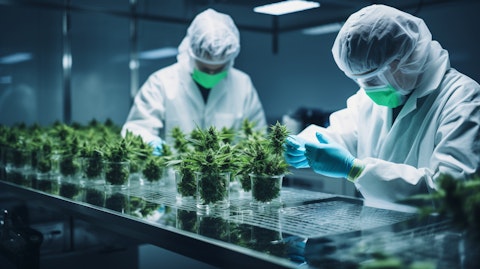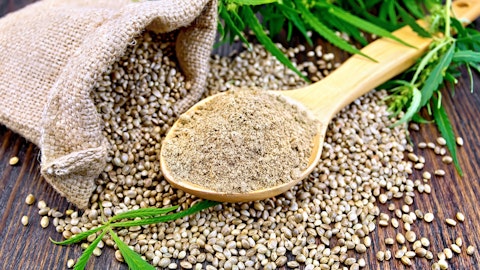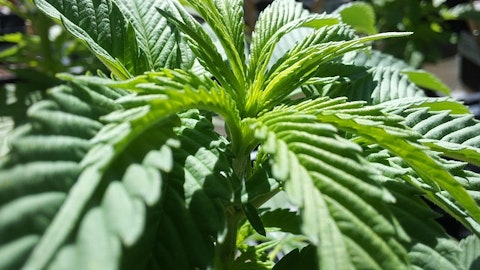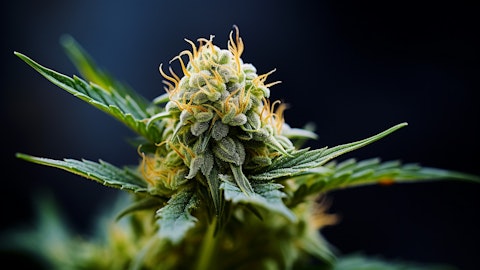Tilray Brands, Inc. (NASDAQ:TLRY) Q2 2024 Earnings Call Transcript January 9, 2024
Tilray Brands, Inc. isn’t one of the 30 most popular stocks among hedge funds at the end of the third quarter (see the details here).
Operator: Thank you for joining today’s conference call to discuss Tilray Brands’ Financial Results for the Second Quarter of Fiscal Year 2024 ended November 30, 2023. All lines have been placed on mute to prevent any background noise. After the speakers’ remarks, there will be a question-and-answer session for analysts and investment firms conducted via audio. I will now turn the call over to Ms. Berrin Noorata, Tilray Brands’ Chief Corporate Affairs and Communications Officer. Thank you. You may now begin.
Berrin Noorata: Thank you, operator, and good morning, everyone. By now, you should have access to the earnings press release, which is available on the Investors section of the Tilray Brands website at tilray.com and has been filed with the SEC and SEDAR. Please note that during today’s call, we will be referring to various non-GAAP financial measures that can provide useful information for investors. However, the presentation of this information is not intended to be considered in isolation or as a substitute for the financial information presented in accordance with GAAP. The earnings press release contains a reconciliation of these non-GAAP financial measure to the most comparable measure prepared in accordance with GAAP.
In addition, we will be making numerous forward-looking statements during our remarks and in response to your questions. These statements are based on our current expectations and beliefs and involve known and unknown risks and uncertainties, which may prove to be incorrect. Actual results could differ materially from those described in those forward-looking statements. The text in our earnings press release includes many of the risks and uncertainties associated with such forward-looking statements. Today, we will be hearing from key members of our senior leadership team, beginning with Irwin Simon, Chairman and Chief Executive Officer, who will provide opening remarks and commentary; followed by Carl Merton, Chief Financial Officer, who will review our quarterly financial results for Q2 fiscal year 2024.
Also joining us for the question-and-answer segment are Denise Faltischek, Chief Strategy Officer and Head of International; Blair MacNeil, President of Tilray Canada; and Ty Gilmore, President of our U.S. Beer business. And now, I’d like to turn the call over to Tilray Brands’ Chairman and CEO, Irwin Simon.
Irwin Simon: Thank you, Berrin, and good morning, everyone, and Happy New Year. We thank you for your continued support of Tilray Brands and for joining our call today. Over the last several quarters, we have been articulating what truly sets Tilray Brands apart, our diversified business model of cannabis CPG lifestyle brands all operating under our strategy innovation, which we believe will drive our continued growth and future success, as we demonstrated by our record revenue in Q2. With the dedication and efforts of our more than 2,300 employees worldwide, we have created a global portfolio of beloved brands and innovative high-quality products backed by best-in-class operations, facilities and robust distribution that supports our goal to become a multi-billion dollar company.
Our four distinct and complementary business segments consist of: cannabis consisting of adult-use and medical cannabis across a broad portfolio of product formats, including whole flower, pre-rolls, vapes, concentrates, oils, edibles, topicals and THC-infused drinks; beverages, including craft beer, spirits, ready-to-drink flavored malt beverages, ciders and energy drinks and non-alcohol beverages; wellness, which consists of our Manitoba Harvest hemp-based food products, ingredients and snacks, as well as our hemp-based CBD infused beverages; and of course, our European medical distribution business, which distributes pharmaceuticals including medical cannabis. In Q2, we continued to focus on organic growth as well as strategic transactions.
In Canada, we maintained our number one market share position with our recent HEXO and Truss acquisitions, which drove considerable cost savings and operational efficiencies. We continue to strengthen our market positions, operations, distribution network and innovation across both medical and adult-use markets. Internationally, we continue to grow our existing medical markets and strengthen our medical distribution and medical cannabis operations through a relentless focus on cost and efficiencies. And finally, we’ve expanded our beverage alcohol business with our recent acquisition of eight iconic brands from Anheuser-Busch, which tripled our beer business from 4 million in cases a year to 12 million cases on an annualized basis. We remain committed to our vision of changing people’s lives for the better, one person at a time.
Guided by this purpose, we are inspiring and empowering the worldwide community to live their very best life, enhanced by moments of connections and well-being. At the same time, we’ve earned the trust of our stakeholders, patients, consumers, communities and partners across the spectrum of our wellness and lifestyle products. In doing so, we’re delivering on our mission to be the most responsible, trusted and market-leading cannabis and consumer products company across the globe. In fact, through our strategic execution and achievements, our business are comprised of: a leading global cannabis business operating best-in-class portfolio of brands with high-quality products that pass the most rigorous quality control regulations in the world with the number one market share in Canada and leading market share in Europe; the fifth largest craft brewer in the U.S. with highly sought-after brands dominating key regions across Northeast, Pacific Northwest and Southeast; and one of the most awarded bourbon brands with Breckenridge Distillery with recent awards, including Best American Blended Whiskey, Best Whiskey Under $50 and 2003 World’s Best Blended Whiskey at the World Whiskey Awards.
And we’re also leader in hemp foods and snacks with our Manitoba Harvest brand. Diversifying our business beyond cannabis has put us in a very strong position today and has positioned us well for future growth opportunities. Today, we do not engage in any cannabis operations in the U.S., due to it being federally illegal. If that and when rescheduling of cannabis were to happen in the U.S., for Tilray Brands, we expect this would open the opportunity for certain institutional investors to invest in Tilray, and that were not previously able to invest in the cannabis industry and potentially provide a path for Tilray to sell pharmaceutical-grade medical cannabis in the U.S., subject to doctor prescriptions. As you know, Tilray is a leading medical cannabis provider in the world.
With our knowledge and expertise in medical cannabis and the regulatory compliance that apply, we’re well positioned to participate in a federally legalized medical market in the U.S. Our underlining goal for Tilray Brands is to continue to deliver industry-leading profitable growth and sustainable long-term shareholder value through our focus on three fundamentals: number one, maximizing profitable revenue growth through organic growth and expansion initiatives as well as key strategic acquisitions with strong synergy opportunities; realizing the benefits of optimized asset utilization and cost management to ensure a lean, efficient cost structure across all our business segments; and continuing to strengthen our industry-leading balance sheet and our cash position.
During Q2, we generated record net revenue for Tilray Brands of $194 million, which marked a 34% growth from the prior-year period, and generated gross profit of $47 million and adjusted gross profit of $52 million. We also significantly reduced our convertible debt by $127 million in the quarter, an additional $18 million after the quarter, and plan to further reduce our indebtedness, optimizing our capital structure and enhancing our financial flexibility. Now moving to our businesses. We grew our Canadian net revenue by 31% in the quarter compared to the previous year, driven by innovation across all product categories. This was achieved both organically and due to recent acquisition despite price compression of approximately $3.6 million from the prior-year quarter, which also negatively impacts offline revenue and profitability.
Tilray continues to maintain the number one market share position in Canada, the largest federally legal cannabis market in the world, with approximately 12.5% market share in adult-use cannabis. This is 570 basis points ahead of the next LP. Tilray leads Canadian adult-use cannabis sales and is number one in Ontario, Quebec and British Columbia, which represents approximately 60% of the Canadian population on a combined basis. We’re also number one in cannabis flower, oils, concentrates and THC beverages, and number two in pre-rolls, number four in vape, and the top 10 on all other categories, all while operating under rigorous high-quality control standards. In Q2, Tilray sold approximately 17 million grams of cannabis flower, 19 million pre-rolls and over 1.5 million units of cannabis beverages, almost 500,000 vapes, and over 400,000 units of edibles in Canada.
And we expect to sell 85 million pre-rolls by the end of fiscal 2024. Our August purchase of the remaining 57.5% equity ownership of Truss Beverage Company from Molson’s Canada elevated our market share in THC beverages to approximately 40% and positions us at the forefront of adult-use beverage sector, where we trusted by patients, healthcare professionals and government officials in over 20 countries and achieved early-mover advantage in new countries as medical cannabis legalization advances. During Q2, we grew our international cannabis net revenue by 55%, and are the market leader in medical cannabis across Europe, with leading shares in Germany and Poland and other countries in which we participate. Similar to the U.S., the growth of our international cannabis business is not dependent on adult-use legalization.
We continue to take an active government relations role internationally. And just recently, we met with various members of German parliament to discuss the proposed regulation and advancing adult-use medical cannabis initiatives, which we believe will increase the accessibility of medical cannabis to patients in Germany and further work to reduce any stigma of medical cannabis as therapeutical option. We’re also optimistic about the potential abolishment of the tender procedure for in-country cultivation in favor of permit procedures, providing Tilray with the flexibility to meet the needs of patients. It is expected that these regulations will be passed in the first quarter of calendar 2024. We remain committed to advancing medical cannabis as evidenced by our investments made in Europe behind our high-quality medical cannabis products and best-in-class facilities in Portugal, Germany where we’re currently one of the only three companies in Germany that can cultivate in country as well as our medical distribution network, led by our integrated medical distribution company with access to approximately 13,000 pharmacies.
We also remain committed to medical cannabis education and research. In October, we announced our support of an independent clinical trial to research the efficacy of medical cannabis as a treatment for glioblastoma. Tilray Pharma, also known as CC Pharma, is an established medical distribution platform for traditional, branded and generic pharmaceuticals, as well as medical cannabis across 13,000 pharmacies as well as wholesalers and distributors. From a revenue perspective, it is currently equal in size to our cannabis segment, comprising of 35% of total sales. In Q2, it grew 12% from the prior-year period, driven by improved procurement of pharmaceutical products and increased demand. From a bottom-line perspective, we are laser-focused on optimizing our medical distribution platform.
In the quarter, we expect the cost optimization plan to reduce costs with the medical distribution segment by $1.5 million annually. The actions to achieve these savings were already executed in the quarter, and we continue to evaluate for further cost optimization and production efficiencies. Now turning to our beverage alcohol business. Beverage alcohol revenue in Q2 was $46.5 million, representing a 117% growth year-over-year, and we’re only getting started in ramping up this segment. The craft beer industry today is still a large category in beverage alcohol, with approximately 21 billion at retail in 2022. With our recent acquisition of eight iconic craft beer and beverage brands, we have anchored Tilray’s leadership position as the fifth largest craft brewer in the U.S. by sales volume.
Working with the Boston Consulting Group, we have developed a beverage strategy, identifying new opportunities for pockets of growth across craft beverages, focusing on brand newness, being more connected to drinkers, and by playing the leading role in driving excitement around craft beer to a broader consumer audience through product innovation, marketing sponsorships and events that connect with consumers across demographics. Tilray Brands is now uniquely positioned to become a Top 12 beer and alcohol beverage company by leveraging our portfolio to win more occasions through core products such as craft beer and beyond through innovation into categories, like flavored malt beverages, ready-to-drink cocktails and spirits. This will be accomplished through a three-pronged approach.
We will deploy a regional approach to scale our brands in key markets across the U.S. and maximize potential of the portfolio to gain share from competitors. We will execute a very focused national brand strategy, revitalizing Shock Top to win as national craft brands by targeting share and connection occasion to reach mainstream male and female beer drinkers. Through one national brand and many regional brands, we will provide robust coverage across the U.S. and other countries. We will expand our innovation strategy to increase brand appeal to new consumers and occasions beyond craft beer in secondary targets. We can also leverage our regional footholds to further grow our brands in new markets by using test and learn tactics, which may include multi-brand, best-of-variety packs or installing multi-brand taps and taprooms before entering the market with full distribution.

We can similarly capture new consumers and increase off-premise consumption through breakneck innovations. We will build on our demonstrated success growing brands such as SweetWater and Montauk to grow our newly acquired consumer-loved brands, including Shock Top, Blue Point, Breckenridge Brewery, 10 Barrel, Redhook Brewery, Widmer Brothers, Square Mile Cider and HiBall Energy. Our strategic playbook is already in play to expand our beverage alcohol business across the U.S. and Canada, and getting our cost structure right, transforming the productivity and profitability of the breweries we acquire, we expect our beer gross margins to increase once we fully realize the cost savings achieved in connection with our fully integrated beverage alcohol platform.
We are aggressively working to launch new innovation across our beer and non-alcoholic craft brands and expect to roll out new products in Q3. Retailer and distribution enthusiasm has already provided confidence in our ability to execute on our growth strategy and to achieve our ambitions to grow our beverage segment into a Top 12 business. Finally, our wellness segment is an important element of our U.S. strategy, due to strong consumer interest in better-for-you snacks and end products. Since the Tilray and Aphria business combination, we turned around the Manitoba Harvest business onto a path of growth and greater potential. Again, product innovation is a core focus, meeting the needs of Gen Z and millennial consumers through new hemp forward snack foods and supplement offering in CBD beverages that fuel your day.
While Q2 revenue was consistent of $12.9 million, Manitoba Harvest branded hemp business continues to expand its U.S. and Canadian leading market share with consumption up in both natural and conventional channels with the brand’s top five customers all seeing growth. To conclude, we’ve set the stage for continued growth in the near and long term, and consider opportunities across our diversified business both numerous and exciting, as we continue to disrupt the global CPG industry with products that fuel consumers’ needs and change people’s lives for the better, one person at a time. In everything that we do, we intentionally do to maximize profitability, sustainable revenue and ensure optimal efficiencies, all while maintaining our balance sheet strength as we invest in our industry-leading brands.
With that, I will now turn the call over to Carl to discuss our financials in greater detail. Carl?
Carl Merton: Thank you, Irwin. As a reminder, our financial results are presented in accordance with U.S. GAAP and in U.S. dollars. We are also referencing both GAAP and non-GAAP adjusted results throughout our discussion today, and our earnings press release contains a reconciliation of our reported results under GAAP to the non-GAAP measures identified during our remarks. Let’s now review our quarterly performance for the three months ended November 30, 2023. Q2 total revenue rose to a record $194 million compared to the prior-year quarter at $144 million, representing 34% growth. And our legacy businesses grew 10% organically, when excluding acquisitions and the HEXO advisory fee. By segment, cannabis net revenue rose 35% in total, with international cannabis up 55% and Canadian cannabis up 31%, despite $3.6 million of price compression in Canada.
Price compression not only negatively impacts top-line revenue, but also profitability, as it would have dropped to the bottom-line. Cannabis excise taxes, which are a reduction to revenue, totaled $27.4 million compared to $16.8 million last year. This reflected a sharp increase in cannabis revenue generated in Canada versus the year-ago period, due in part to the HEXO and Truss acquisitions and a change in our revenue mix to higher excise tax products. Note that excise tax is predominantly computed as a fixed price on grams sold rather than as a percentage of the selling price, and therefore continues to become a larger component of net revenue, particularly as current growth categories like infused pre-rolls and concentrates become the biggest part of our sales mix.
While an excise tax force has been established to present these challenges to the Minister of Finance in Canada, we do not believe some level of reform is likely in the near term. Still, about two-thirds of LPs have excise taxes owed, and this could lead to additional insolvencies and even more industry consolidation, which is needed to stabilize the industry. Distribution revenue from our Tilray Pharma, also known as CC Pharma, European medical distribution business rose 12%, net beverage alcohol revenue rose 117%, and wellness revenue rose 2%. The inherent benefits of our diversified business model are reflected in this segment contributions to our overall revenue mix. We are not overly dependent on any business line from a top-line or gross profit standpoint, and believe each segment, including cannabis, wellness, distribution and beverage alcohol, are on a trajectory for sustainable growth.
In Q2, our cannabis segment represented about 35% of our total revenue mix comparable to last year; distribution segment represented 35%, down from 42% last year; beverage alcohol represented 24%, up from 15% last year; and wellness represented about 7%, down from 9% last year, respectively. These percentage changes from Q2 last year are due primarily to contributions from HEXO, Truss and the new craft beverage brands acquired in early October. Next quarter, we believe the mix will balance to approximately 30% cannabis, 30% distribution, 30% beverage alcohol and 10% wellness. Diversification is also reflected in our geographic footprint, with about 60% of our net revenue from North America and slightly less than 40% from EMEA, with the remainder from other parts of the world.
Turning to profitability. Gross profit increased 11% to $47.4 million compared to $42.9 million in the prior-year quarter, while gross margin decreased to 24% from 30% in the prior-year quarter. While gross margin for U.S. GAAP purposes declined from the prior year, adjusted gross margin, exclusive of the impacts of the HEXO advisory fee which ceased after we purchased HEXO, rose to 27% compared to 26%. I will discuss adjusted gross margin by individual segment in a moment. Net loss improved to $46.2 million compared to net loss of $61.6 million in the prior-year quarter. On a per share basis, this amounted to net loss of $0.07 versus $0.11 in the prior-year quarter. During Q2, we renegotiated a supply agreement between Aphria Inc., a wholly-owned subsidiary, and Aphria Diamond, a non-wholly-owned subsidiary, that is expected to result in $33 million annually in additional income being allocated to Tilray shareholders as opposed to the non-controlling interests.
Further, as part of this renegotiation, we believe we will save more than $22 million annually in cash income taxes. The renegotiated supply agreement was effective September 1, 2023. If this amended agreement had been implemented at the onset of the fiscal year, it would have improved our loss per share attributable to Tilray shareholders by $0.02 for Q1, which would have increased the value attributable to Tilray stockholders by $15 million. Despite all of this, we still expect to pay over $140 million in Canadian excise tax this year. Beginning this quarter, we are introducing two new reporting metrics to our discussions: adjusted net income loss and adjusted earnings per share. The definitions of both are identified in the press release, along with the relevant reconciliations and calculations.
For the quarter, we are reporting an adjusted net loss of $2.7 million, which when calculated on a per share basis resulted in EPS of $0 for the quarter. Adjusted EBITDA was $10.1 million, down from $11 million in the prior-year quarter. This was consistent with the termination of the HEXO advisory services contract upon our acquisition of HEXO, which represented $7.8 million of the $11 million in adjusted EBITDA in the prior-year period. During the quarter, we continued to make great progress against the HEXO synergy plan, increasing the amount of the synergy from $27 million to between $30 million and $35 million. As of the end of the quarter, we achieved $22 million in annualized savings on an annualized run rate basis, of which $14 million represented actual cost savings during the period.
These synergies are being achieved via consolidating packaging, procurement, freight and logistics. Operating cash flow was negative $30.4 million compared to positive $29.2 million in the prior-year quarter. The increase in cash used during Q2 this year was primarily related to the settlement of pre-acquisition liabilities assumed in connection with the HEXO acquisition and an increase in accounts receivable in the current period. Also, the prior period included a working capital reduction and the cash collection of $18.3 million from HTI related to the HEXO convertible note, which did not recur in the current year. Turning now to our business segments. Gross cannabis revenue of $94.6 million was comprised of $72 million in Canadian adult-use revenue, $11.9 million in international cannabis revenue, $6.3 million in Canadian medical revenue, and $4.3 million in wholesale cannabis revenue.
Net cannabis revenue was $67.1 million, representing a 35% increase from the year-ago period. The positive variance related to increased organic growth of over 11% and the acquisitions of HEXO and Truss. Offsetting the increase in net cannabis revenue was the elimination of the advisory services revenue from the prior-year quarter due to the HEXO acquisition, which terminated the previous strategic arrangement that was in place. International cannabis grew 55%, largely because of the expansion into emerging international medical markets. Additionally, in the prior period, the company recognized a one-time return adjustment of $3.1 million related to a former customer in Israel. Cannabis gross profit was $20.6 million and cannabis gross margin was 31% compared to $21.3 million and 43% in the prior-year quarter.
Excluding the HEXO advisory fee and return adjustment in the prior-year quarter and the wholesale sale in the current quarter, adjusted cannabis gross margin increased to 37% from 33%. As I just referenced, a portion of the decrease in gross profit was a result of the termination of the HEXO services agreement. This agreement contributed nil of gross profit in the current year compared to $7.8 million in the prior year. Additionally, we made a significant wholesale transaction that resulted in negative gross profit of $0.2 million. We entered into this agreement to optimize our inventory levels and prioritize the generation of positive operating cash flow. European distribution revenue, derived predominantly through CC Pharma, increased 12% to $67.2 million from $60.2 million in the prior-year quarter.
The increase was driven by the strengthening of the euro relative to the U.S. dollar, increased capacity through outsourcing the third-party production facilities, as well as leveraging internal production and improved procurement processes. This has allowed Tilray Pharma to improve its product mix. We also continue to be focused on optimizing portfolio and production capacity to prevent constraints on continued revenue growth. Tilray Pharma gross profit decreased to $7.1 million compared to $7.7 million in the prior year. Tilray Pharma gross margin decreased to 11% from 13% in the prior-year quarter, which was due to product mix. Beverage alcohol revenue was $46.5 million, up 117% from $21.4 million in the prior-year quarter. The positive delta was due to contributions from increased organic growth of over 10% and our Montauk Brewery acquisition last November and the newly acquired brands acquired in early October this year.
Beverage alcohol gross profit increased to $16 million compared to $10 million, while average — beverage alcohol gross margin decreased to 34% from 47% in the prior-year quarter. Adjusted gross margin from beverage alcohol from our legacy business was 54.8%, up from the prior-year quarter of 47%. Adjusted gross margin from our newly acquired craft brands was 21%. Irwin has previously addressed the efforts we are extending to improve the newly acquired craft brands adjusted gross margins to levels consistent with our legacy beer adjusted gross margins. Wellness revenue was relatively consistent at $12.9 million compared to $12.7 million in the prior-year quarter, with the increase being driven by a promotional sale at a large bulk retailer.
Wellness gross profit was $3.7 million, down from $3.9 million in the prior-year quarter and gross margin fell to 29% from 31% as we experienced a change in sales mix towards more bulk retail sales, which have a lower margin that is specific for this quarter. Our cash and marketable securities balance as of November 30th was $261.4 million, down from $433.5 million in the year-ago period. The majority of the decrease related to the redemption of the Tilray ’23 convertible notes upon maturity in the amount of $107.3 million combined with litigation settlements inherited from acquired businesses and HEXO costs. Having now completed half of our fiscal year, we are reiterating our fiscal ’24 guidance of adjusted EBITDA between $68 million and $78 million.
Note that when we first issued this guidance, we projected a significant step-up in EBITDA contributions during the second half of the year, most particularly in Q4, which we continue to anticipate. This step-up is a function of our beer business, leading up to the summer, a historically busy season, the new innovation scheduled to be launched as part of the spring reset, certain volume guarantees associated with our spirits business and in our distribution business as pharmacies buy in bulk [indiscernible] customers ahead of them going on vacation. Recall that we also project positive adjusted free cash flow from operations, excluding our integration costs from HEXO, Truss, the newly acquired brands, and the cash income taxes related to Aphria Diamond.
We are also managing CapEx and working to strengthen our industry-leading balance sheet. Let me now conclude our prepared remarks and open the lines for questions from our covering analysts. Operator, what’s the first question?
See also 20 Best Beer Countries Heading into 2024 and 25 Best Campsites in the US.
Q&A Session
Follow Tilray Brands Inc. (NASDAQ:TLRY)
Follow Tilray Brands Inc. (NASDAQ:TLRY)
Operator: Thank you. Our first question is from the line of Andrew Carter from Stifel. Please proceed with your question, sir.
Andrew Carter: Hi. Thank you. Good morning. So, looking at back half guidance, I appreciate kind of what you just said. But if I’ve got my math right, then you need $16 million to $40 million of incremental EBITDA in the second half of the year. And then you’ve got $25 million second half last year from HEXO fees. So, $35 million to $45 million of incremental EBITDA to meet the guidance in the second half. Could you talk about kind of stepped up seasonality, how much that’s going to contribute, incremental synergy capture year-over-year or making progress on kind of the ABI — the ABI craft brands, gross margin, how much would be in second half? And then kind of one more within this quarter, how much was kind of one-time costs associated with the ABI, obviously not things you excluded, that could swing to profit second half and help that number? Thank you.
Carl Merton: Thanks, Andrew. So, just in terms of a number of the items, first off, when we look at the HEXO and Truss acquisitions, we’ve increased our synergy target to $30 million to $35 million. We already have $22 million of that and got $14 million of it in the most recent quarter. So, you’re going to see that flow through the historic HEXO numbers through the end of the year. We’re seeing increased seasonality in the cannabis — the Canadian cannabis business in Q4. We see increased seasonality every year in the distribution business in Q4, every year except for the two years of COVID. And that’s really driven by pharmacy stocking up on medicines in advance of the summer months when a lot of Germans disappear from Germany for their holidays over the summer and they buy in advance.
As you go through and we look at the ABI transaction — sorry, the newly acquired brands, what we’re seeing is even more seasonality than SweetWater, and we all know what happened last year with SweetWater and Montauk in the fourth quarter. And so, we see profitability increases there as well. We have a couple of internal cost savings plans that are going to net us about $5 million over the back half of the year. And we have invested immensely in new innovation for both ABI and for SweetWater for that spring reset in the back half of the year.
Irwin Simon: And Andrew, I think the big thing is this here, you got to remember, we closed on the ABI deal only two months ago. So, we really didn’t get any benefits from it. But you got to step back. Our beer business was up 10% in this quarter, where traditional beer businesses have been down or flat. So, we’re seeing some good organic growth from our beer business. We’re seeing good organic growth from our cannabis business. You saw what happened in Europe. You saw what happened in our Canadian market, and that’s even with price compression. So, let’s step back, you heard what we said. We increased our synergies that we’re going to get now from the HEXO deal, $30 million to $35 million. We are only operating that for about three months.
We closed on Truss. We’re consolidating that business into our London facility. And we have a major market share on that. So, we’re well positioned. I think the big thing is how do we take and get organic growth is key, number one. Number two is cost savings. And we put in place very early on or just at a corporate tier, we’ve taken about $5 million, $6 million and then focusing on the integration of the HEXO business, the Truss business and the ABI deal. And then last but not least, we got a lot of innovation coming out in our product line, both in beer and cannabis. So, we feel there’s a good path to achieve the back half.
Andrew Carter: Second question, just from Canada, you mentioned the price compression ongoing obviously at a much lower rate, but it’s still a headwind to the profit. You also mentioned mix going kind of where the consumer is, that’s degradation. I mean, at a certain point looking at Canada, do you see the profit pool increasing? And I guess, risk — you mentioned two-thirds of LPs aren’t paying kind of regressive tax — taxes owed. Do you see any risks there that number one, enforcement obviously isn’t happening? But number two, there could be settlements or whatever that could make basically the whole kind of Canada adult-use market just a very difficult value proposition overall to where you would kind of reconsider investment in that? Thanks.
Irwin Simon: So, we’ll step back for a second. Listen, Canada is the only market in the world where recreational cannabis is legal. We have one of the largest share. We’re number one in Ontario, number one in Quebec and number one in British Columbia, which is over 60% of the population. What we’re seeing in Canada, yes, we don’t like price compression and we got a 12.5%, 13% share with our next competitor out there, about 4.5% share points lower. What we have to focus on is a couple of things. More and more sales, number one. Number two, taking more and more cost out. You heard Carl talk about renegotiating our agreement and taking costs out of our agreement with our grower. As we bring HEXO in there, we’re looking to take $35 million of total cost out of there.





